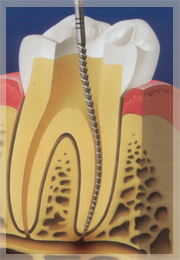At the present time, 20 million root canals are performed each year on dental patients. The long term success of this treatment is over 90%! Root canal treatment, also called endodontic treatment, involves relieving pain and discomfort by removing the nerve tissue (pulp) located in the center of the tooth and its root or roots (the root canal). Treatment involves making an access opening through the biting surface of the tooth to expose the pulp. The pulp tissue is removed with very fine metal files. Medication may be placed within the canals help sterilize the interior of the tooth if there is a significant infection present.
 Each empty root canal is filled with a rubber-like material called gutta percha and medicated cement. Occasionally a metal post is also inserted into the canal to help support a new crown. After root canal treatment we close the opening in the tooth with a temporary filling. After your root canal treatment is completed your dentist will place a permanent filling, and a crown (also called a cap) may be placed.
Each empty root canal is filled with a rubber-like material called gutta percha and medicated cement. Occasionally a metal post is also inserted into the canal to help support a new crown. After root canal treatment we close the opening in the tooth with a temporary filling. After your root canal treatment is completed your dentist will place a permanent filling, and a crown (also called a cap) may be placed.
Twisted, curved or blocked root canals may prevent removal of all inflamed or infected pulp. Leaving any pulp in the root canal may cause your symptoms to worsen. If the pulp tissue canʼt be removed you may need an additional procedure called an apicoectomy. Through a small opening cut in the gum and bone, the root tip is removed and the root canal is sealed. An apicoectomy may also be required if your symptoms continue after your treatment has been completed and your tooth does not heal.
Once the root canal treatment is completed, it is essential to return promptly to your dentist to have your tooth properly restored. Because a temporary filling is designed to last only a short time (about six to eight weeks), failing to return to your dentist as directed to have the tooth sealed permanently with a crown can lead to the deterioration of the seal, resulting in decay, infection, gum disease and the possible premature loss of the tooth. Root fractures can also occur if you fail to have the tooth properly covered by your general dentist.
Root canal treatment is intended to allow you to keep your tooth for a longer period, which will help to maintain your natural bite and the healthy functioning of your jaws. There is no substitute for the natural tooth as good as the tooth itself, so we strongly feel that if the tooth can be saved, it is in your best interest to try and save it. However, if the tooth cannot be saved, there are several good alternatives. Extracting your tooth is the most common alternative to root canal treatment. This alternative may require replacing the extracted tooth with a removable or fixed bridge or an artificial tooth called an implant.
OVER 90% OF ALL ROOT CANAL TREATMENTS ARE SUCCESSFUL
COMMON RISKS
 In 2001, he received his Certificate in Endodontics and a Masters of Science in Dentistry. Read more about Dr. Risser
In 2001, he received his Certificate in Endodontics and a Masters of Science in Dentistry. Read more about Dr. Risser